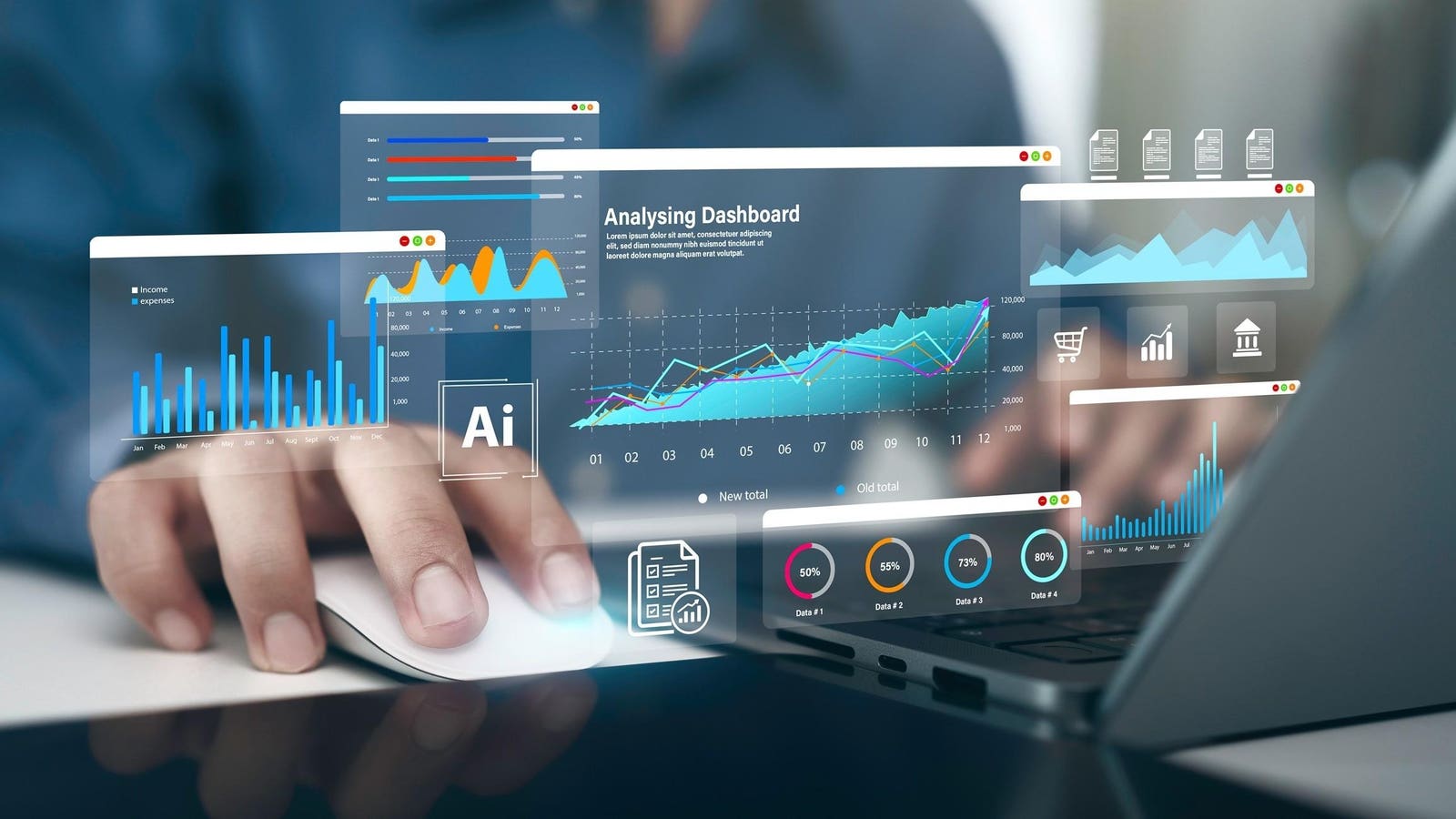Innovation and Technology
The 8 Critical Energy Trends Defining 2025

AI-Powered Infrastructure to Breakthrough Battery Technology: The Most Dramatic Transformation in Decades
From cooking food to heating and lighting our homes and powering industry, energy is central to life on Earth and the advancement of human society. But the way we access, store, and use energy is evolving rapidly, driven by environmental concerns, new technological developments, and geopolitical challenges.
AI in Energy Infrastructure and Management
Predictive analytics and smart energy optimization solutions, all made possible thanks to the ongoing AI revolution, will continue to enable more precise forecasting of energy demands and real-time optimization of energy generation, storage, and distribution. It will also play a role in green energy exploration. Companies like Shell are already leveraging AI to help identify deposits of biofuel, as well as optimize the placement of EV charging stations, and accelerate their research into clean energy solutions.
Innovation in Energy Storage and Battery Technology
New types of battery storage, such as solid-state and flow batteries, will continue to make renewable energy storage a more viable solution in 2025. This will enable more reliable integration of solar, tidal, and wind energy sources into energy grids, with scalable solutions that address the problems of intermittency that traditionally come with these methods of generating power. Other potential solutions will come in the form of thermal energy and compressed air storage, creating further possibilities for easing the energy crisis.
Decentralized Energy Production
Rather than centralized energy production carried out at large facilities, the principle of decentralized energy involves millions of smaller-scale microgrids and energy-sharing systems, combining renewable and clean energy generators with AI-powered management systems. These could be owned and operated by community groups or neighborhoods, creating local energy ecosystems that will increase energy resilience and reduce reliance on central providers.
Geopolitics Drives Energy Security Challenges
Turbulent political tensions are forcing nations to prioritize energy security, diversify their supply of energy, and develop new supply routes. In 2025, many companies – particularly those that are reliant on energy supplied by countries involved in war or political trouble – will focus on reducing dependency on imports and increasing domestic energy production.
The Nuclear Options
The development of small modular reactors, as well as potential breakthroughs in the quest for fusion, promise safer and more easily affordable nuclear power. This could create new opportunities for reliable, low-carbon power generation that will increasingly be used alongside renewable energy in the pursuit of clean energy goals. SMRs are smaller, safer, and cheaper than conventional nuclear power plants, making them increasingly seen as an attractive option for replacing aging fossil fuel plants in 2025. Some, however, remain concerned that not all concerns around nuclear power will be alleviated.
Addressing Energy Inequality
The need to address energy poverty and inequality is increasingly becoming a global priority. Across the world, billions of people still have limited or no access to reliable electricity supplies, severely endangering their health and limiting the possibility of economic development. In 2025, developing new methods of supplying affordable and clean energy to some of the most underserved regions will be an increasingly urgent priority.
New Developments in Renewable and Green Energy Sources
Worldwide, there is still a tremendous appetite for replacing fossil fuels and polluting energy supplies with clean, green alternatives. As well as new developments in renewable generation such as more efficient, integrated solar panels (photovoltaics) and floating wind farms (floatovoltaics), green hydrogen is emerging as a viable solution for reducing carbonization of industries such as steel and chemical production, as well as transport.
The Human Factor
The most critical element in energy transformation could be the role played by human behavior. From the appetite for transitioning away from fossil fuels to participation in community energy programs, the question of whether individuals will be willing to make changes to their habits will be a deciding factor. Legislation will play its part, but may provoke kickback if handled too heavily, as seen by the reaction of some to measures such as EV mandates. Education will be even more vital in raising awareness of the deadly scenarios we will face in the future if we don’t effectively manage energy transitions today.
Conclusion
The global energy landscape is undergoing its most dramatic transformation in decades. As we head into 2025, innovation and changes in human behavior will both be vital to finding solutions. With AI-powered infrastructure, breakthrough battery technology, and new developments in renewable and green energy sources, the future of energy looks promising. However, addressing energy inequality, security challenges, and the human factor will be crucial in ensuring a sustainable and resilient energy system for generations to come.
FAQs
- What are the key trends in new energy sources and energy transformation in 2025?
- AI-powered infrastructure, battery technology, decentralized energy production, and new developments in renewable and green energy sources.
- What is the role of AI in energy infrastructure and management?
- AI will enable more precise forecasting of energy demands and real-time optimization of energy generation, storage, and distribution.
- What are the potential solutions for energy storage in 2025?
- Solid-state and flow batteries, thermal energy, and compressed air storage.
- How will human behavior impact energy transformation?
- Human behavior, including the appetite for transitioning away from fossil fuels and participation in community energy programs, will be a deciding factor in energy transformation.
Innovation and Technology
Business Essentials

Introduction to AI Agents and Agentic AI
The generative AI boom, catalyzed by OpenAI’s ChatGPT in late 2022, ushered in a new era of intelligent systems. But as businesses push beyond static language models, two paradigms have emerged in automation, central to the future of enterprise AI: AI agents and agentic AI.
Distinctions Between AI Agents and Agentic AI
While both represent an evolution from generative systems, their operational scopes are redefining how organizations approach automation, decision-making and AI transformation. As enterprise leaders seek to integrate next-gen AI into their workflows, understanding the distinctions between AI agents and agentic AI for automation — and their distinct strategic advantages — has now become an operational imperative.
AI Agents: Autonomous Task Execution
Traditional AI agents are autonomous software systems that execute specific, goal-oriented tasks using tools like APIs and databases. They are typically built on top of large language models such as GPT-4 or Claude 3.5, and they excel in domains like customer service, scheduling, internal search and email prioritization. What differentiates AI agents from generative AI is their tool-augmented intelligence — they don’t just respond to prompts; they plan, act and iterate based on user goals set up earlier in the process.
Examples of AI Agents
Popular implementations include OpenAI’s Operator or ClickUp Brain — agents that autonomously complete HR tasks, automate workflows or even handle enterprise search across documentation platforms. AI agents have reduced customer support ticket resolution time by over 40% and increased internal knowledge retrieval accuracy by 29%, according to recent benchmarks.
Agentic AI: Coordinated Intelligence
Agentic AI represents an architectural leap beyond standalone agents. These systems are composed of multiple specialized agents — each performing distinct subtasks — coordinated by a central orchestrator or decentralized communication layer. Think of it as an intelligent ecosystem rather than a single-function intelligent tool.
Applications of Agentic AI
Agentic systems shine in high-complexity environments requiring breaking down goals, contextual memory, dynamic planning and inter-agent negotiation. In applications like supply chain optimization, autonomous robotics and research automation, they outperform single-agent systems by enabling concurrent execution, feedback loops and strategic adaptability.
Real-World Use Cases
Consider a real-world use case: a research lab using a multi-agent AutoGen pipeline to write grant proposals. One agent retrieves prior funded documents, another summarizes scientific literature, a third aligns objectives with funding requirements and a fourth formats the proposal. Together, they produce drafts in hours, not weeks — reducing overhead and boosting approval rates.
Challenges and Limitations
While promising, both AI agents and agentic AI face notable challenges. AI agents struggle with hallucinations, brittleness in prompt design and limited context retention. Agentic AI, on the other hand, contends with coordination failures, emergent unpredictability and explainability concerns.
The Future Of AI Agents And Agentic AI
Although we’re still very much in the infancy stages, AI continues its meteoric rise and the transition from reactive generative models to autonomous, orchestrated agentic systems marks a pivotal inflection point. AI agents have already proven their value in automating tasks, but agentic AI is redefining what’s possible in strategic domains — from scientific research to logistics and healthcare.
Conclusion
For business leaders, organizations that master this next frontier of intelligence and automation won’t just become more efficient and productive — they have the chance to innovate, scale and lead in ways never been seen before.
FAQs
Q: What is the main difference between AI agents and agentic AI?
A: AI agents are autonomous software systems that execute specific tasks, while agentic AI is a system composed of multiple specialized agents coordinated by a central orchestrator.
Q: What are the applications of AI agents?
A: AI agents excel in domains like customer service, scheduling, internal search and email prioritization.
Q: What are the challenges faced by AI agents and agentic AI?
A: AI agents struggle with hallucinations, brittleness in prompt design and limited context retention, while agentic AI contends with coordination failures, emergent unpredictability and explainability concerns.
Q: What is the future of AI agents and agentic AI?
A: The transition from reactive generative models to autonomous, orchestrated agentic systems marks a pivotal inflection point, and organizations that master this next frontier of intelligence and automation will have the chance to innovate, scale and lead in ways never been seen before.
Innovation and Technology
20 Mind-Blowing AI Statistics

Introduction to Artificial Intelligence Adoption
The integration of artificial intelligence into daily life has accelerated at an unprecedented pace, transforming everything from internet search results to customer service interactions and workplace productivity tools in ways that seemed impossible just two years ago. Beyond consumer applications, AI now plays a critical role in geopolitical conflicts, electoral processes, and addressing global challenges like climate change and healthcare delivery. This widespread deployment means AI’s influence extends far beyond individual users to shape broader economic and social systems that affect everyone, regardless of their personal technology adoption.
The Scope of AI Transformation
The scope and speed of this transformation demand a data-driven understanding of where we stand today and where current trends are leading us. Numbers tell stories and one thing we can be sure of in the digital age is that the revolution will be quantified. Data on adoption, usage, and societal impact (job losses, for example) helps businesses understand investments but also helps the rest of us anticipate further change. So here are 20 statistics that best reflect where we are in 2025 that can help us decode the many narratives and trends around AI.
Adoption And Investment
- $244bn Market Size: The value of the global industry for AI tools and services, representing a 31% increase over the previous year and predicted to rise to $1 trillion by 2031.
- 66% Of People Use AI Regularly: AI is an everyday reality for two-thirds of the planet’s population, according to this study.
- 378 Million Will Use AI Tools In 2025: Up from just 116 million five years ago, 64 million higher than the previous year, making it the largest year-on-year jump.
- 78% Of Organizations Use AI: Up from 55% the previous year, as reported by the Stanford HAI 2025 AI Index.
- 90% Of Hospitals Use AI For Diagnosis and Monitoring: This reflects the enthusiastic uptake of AI across the healthcare sector in many countries.
- 92% Of Students Use Generative AI: This has shot up from 66% in 2024, with 18% admitting to submitting AI-generated text with their work.
- 51% Of Marketers Already Using Generative AI: According to this Salesforce survey, with a further 22% planning to start using it soon.
Society And AI
- 46% Of Us Trust AI: Trust is critical for AI adoption, but this study shows there is some way to go.
- 56.4% Increase In Harmful AI Incidents: One index that tracks harmful AI incidents, such as damaging deepfake images and chatbot misinformation, reported this increase.
- 76% Of Experts Believe The Benefits Outweigh The Risks: Those with specialist knowledge are far more likely to believe AI is worthwhile compared to just 43% of the general public.
- 60% Of The World’s Population Lives In A Jurisdiction Covered By AI Legislation: Due to the passing of AI legislation by a growing number of countries, this has increased from 10-15% since 2020.
- 54% Of Us Will Use AI To Make Consumer Decisions: And this survey suggests we’re increasingly using generative AI to shop around.
- 35% Of Parents Discuss AI With Kids: Although this increases significantly among groups with higher levels of education, according to research.
Energy And Environmental Footprint
- 23 Gigawatts Of Electricity Will Be Burned To Power AI in 2025: This is about the same as the power usage of the United Kingdom.
- 0.5 Liters Of Water: Is used to cool data center servers for the average ChatGPT user session.
- 1.7 Gigatons of additional CO2 emissions will be created by AI use between 2025 and 2030, according to the IMF.
Jobs
- 50% Of White Collar Jobs Could Be Lost To AI: According to predictions made by Anthropic CEO Dario Amodei, calling for major changes to the way we approach job displacement.
- Women 3X More Likely To Be Displaced: Prompting calls to ensure automation doesn’t worsen workplace gender disparity.
- 40% Of Jobs Are Exposed To AI Impact: According to the IMF, which found greater exposure in advanced economies.
- 31% Downturn In Job Vacancies For “Highly Exposed” Roles: This suggests that people are already being replaced in roles such as database administration and IT specialist.
Conclusion
The numbers paint a clear picture: we’re living through an AI revolution that’s accelerating faster than most anticipated. While the technology promises incredible benefits across healthcare, education, and business, the statistics also reveal serious challenges around job displacement, energy consumption, and the growing digital divide. As we navigate 2025, the key question isn’t whether AI will reshape our world but whether we can harness its power while protecting the workers and communities most vulnerable to its disruptive effects. The data suggests we have little time to waste in finding those answers.
FAQs
- What is the projected market size of the AI industry by 2025?
- The AI market is projected to reach $244 billion by 2025.
- How many people are expected to use AI tools in 2025?
- 378 million people are expected to use AI tools in 2025.
- What percentage of organizations use AI?
- 78% of organizations use AI, according to the Stanford HAI 2025 AI Index.
- How does AI impact job markets?
- AI could potentially displace up to 50% of white-collar jobs and has a significant impact on job vacancies for highly exposed roles.
- What are the environmental concerns related to AI?
- The use of AI is expected to create 1.7 gigatons of additional CO2 emissions between 2025 and 2030, and it consumes significant amounts of electricity and water for data center operations.
Innovation and Technology
The Most Common Digital Transformation Mistakes (and How to Avoid Them)

Implementing digital transformation strategies can be a daunting task, as it requires significant changes to an organization’s culture, processes, and technology. In this article, we’ll explore the most common digital transformation mistakes and provide guidance on how to avoid them. With the right approach, businesses can unlock the full potential of digital transformation and stay ahead of the competition.
Understanding Digital Transformation
Digital transformation is a comprehensive approach to integrating digital technology into all areas of a business. It involves a cultural shift, where organizations embrace new ways of working, innovating, and delivering value to customers. To succeed, businesses must be willing to experiment, learn from failures, and continuously adapt to changing market conditions.
Defining Digital Transformation Goals
Before embarking on a digital transformation journey, it’s essential to define clear goals and objectives. This includes identifying the key drivers of change, such as improving customer experience, increasing operational efficiency, or driving innovation. By setting specific, measurable, and achievable goals, businesses can create a roadmap for success and ensure everyone is working towards the same outcomes.
Assessing Digital Maturity
Assessing an organization’s digital maturity is critical to understanding its readiness for transformation. This involves evaluating the current state of technology, processes, and culture, as well as identifying areas for improvement. By conducting a thorough assessment, businesses can identify potential roadblocks and develop targeted strategies to address them.
Common Digital Transformation Mistakes
Despite the best intentions, many businesses make critical mistakes during their digital transformation journeys. These mistakes can be costly, time-consuming, and even derail the entire transformation effort.
Lack of Clear Vision and Strategy
One of the most common mistakes is the lack of a clear vision and strategy. Without a well-defined plan, businesses can struggle to prioritize initiatives, allocate resources, and measure progress. This can lead to confusion, frustration, and a lack of momentum.
Insufficient Change Management
Digital transformation requires significant changes to an organization’s culture, processes, and technology. Insufficient change management can lead to resistance, fear, and uncertainty among employees, which can hinder the transformation effort.
Inadequate Technology Infrastructure
A robust technology infrastructure is essential for supporting digital transformation. Inadequate infrastructure can lead to system crashes, data breaches, and other technical issues that can undermine the transformation effort.
Failure to Engage Stakeholders
Digital transformation affects multiple stakeholders, including customers, employees, and partners. Failing to engage these stakeholders can lead to a lack of buy-in, adoption, and ultimately, a failed transformation effort.
Best Practices for Digital Transformation
To avoid common mistakes and ensure a successful digital transformation, businesses should follow best practices.
Develop a Clear Vision and Strategy
Developing a clear vision and strategy is critical to digital transformation success. This involves defining specific goals, objectives, and key performance indicators (KPIs) that align with the organization’s overall mission and vision.
Establish a Strong Governance Structure
A strong governance structure is essential for ensuring that digital transformation initiatives are properly managed, coordinated, and resourced. This includes establishing clear roles, responsibilities, and decision-making processes.
Foster a Culture of Innovation and Experimentation
Digital transformation requires a culture of innovation and experimentation. Businesses should encourage employees to think creatively, experiment with new ideas, and learn from failures.
Invest in Employee Training and Development
Digital transformation requires new skills and competencies. Investing in employee training and development is essential for ensuring that employees have the necessary skills to support the transformation effort.
Measuring Digital Transformation Success
Measuring digital transformation success is critical to evaluating progress, identifying areas for improvement, and making informed decisions.
Defining Key Performance Indicators (KPIs)
Defining KPIs is essential to measuring digital transformation success. This includes metrics such as customer engagement, operational efficiency, and revenue growth.
Monitoring Progress and Adjusting Course
Monitoring progress and adjusting course is critical to ensuring that digital transformation initiatives stay on track. This involves regularly reviewing KPIs, identifying areas for improvement, and making adjustments as needed.
Conclusion
Digital transformation is a complex and challenging journey, but with the right approach, businesses can unlock significant benefits and stay ahead of the competition. By understanding common mistakes, following best practices, and measuring success, businesses can ensure a successful digital transformation and achieve their goals.
Frequently Asked Questions (FAQs)
What is digital transformation?
Digital transformation is a comprehensive approach to integrating digital technology into all areas of a business, involving a cultural shift, new ways of working, innovating, and delivering value to customers.
Why is digital transformation important?
Digital transformation is important because it enables businesses to stay competitive, improve customer experience, increase operational efficiency, and drive innovation.
How long does digital transformation take?
Digital transformation is a continuous process that requires ongoing effort and commitment. The duration of a digital transformation journey varies depending on the organization’s size, complexity, and goals.
What are the common mistakes in digital transformation?
Common mistakes in digital transformation include lack of clear vision and strategy, insufficient change management, inadequate technology infrastructure, and failure to engage stakeholders.
How can businesses ensure digital transformation success?
Businesses can ensure digital transformation success by developing a clear vision and strategy, establishing a strong governance structure, fostering a culture of innovation and experimentation, investing in employee training and development, and measuring success through defined KPIs.
-

 Career Advice6 months ago
Career Advice6 months agoInterview with Dr. Kristy K. Taylor, WORxK Global News Magazine Founder
-

 Diversity and Inclusion (DEIA)6 months ago
Diversity and Inclusion (DEIA)6 months agoSarah Herrlinger Talks AirPods Pro Hearing Aid
-

 Career Advice6 months ago
Career Advice6 months agoNetWork Your Way to Success: Top Tips for Maximizing Your Professional Network
-

 Changemaker Interviews5 months ago
Changemaker Interviews5 months agoUnlocking Human Potential: Kim Groshek’s Journey to Transforming Leadership and Stress Resilience
-

 Diversity and Inclusion (DEIA)6 months ago
Diversity and Inclusion (DEIA)6 months agoThe Power of Belonging: Why Feeling Accepted Matters in the Workplace
-

 Global Trends and Politics6 months ago
Global Trends and Politics6 months agoHealth-care stocks fall after Warren PBM bill, Brian Thompson shooting
-

 Global Trends and Politics6 months ago
Global Trends and Politics6 months agoUnionization Goes Mainstream: How the Changing Workforce is Driving Demand for Collective Bargaining
-

 Training and Development6 months ago
Training and Development6 months agoLevel Up: How Upskilling Can Help You Stay Ahead of the Curve in a Rapidly Changing Industry



















